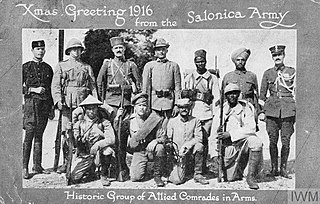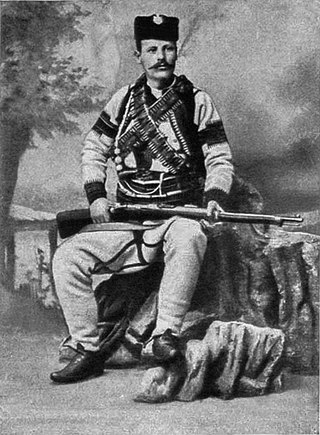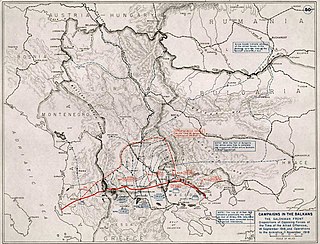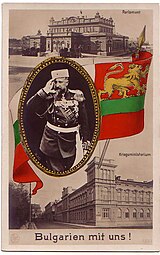
The region of Macedonia is known to have been inhabited since Paleolithic times.

The Internal Macedonian Revolutionary Organization, was a secret revolutionary society founded in the Ottoman territories in Europe, that operated in the late 19th and early 20th centuries.
The Bulgarian First Army was a Bulgarian field army during the Balkan Wars, World War I and World War II.

The Balkans theatre or Balkan campaign was a theatre of World War I fought between the Central Powers and the Allies.

The Macedonian front, also known as the Salonica front, was a military theatre of World War I formed as a result of an attempt by the Allied Powers to aid Serbia, in the autumn of 1915, against the combined attack of Germany, Austria-Hungary and Bulgaria. The expedition came too late and with insufficient force to prevent the fall of Serbia and was complicated by the internal political crisis in Greece. Eventually, a stable front was established, running from the Albanian Adriatic coast to the Struma River, pitting a multinational Allied force against the Bulgarian army, which was at various times bolstered with smaller units from the other Central Powers. The Macedonian front remained stable, despite local actions, until the Allied offensive in September 1918 resulted in Bulgaria capitulating and the liberation of Serbia.

The Battle of Dobro Pole, also known as the Breakthrough at Dobro Pole, was a World War I battle fought between 15 and 18 September 1918. The battle was fought in the initial stage of the Vardar Offensive, in the Balkans Theatre. On 15 September, a combined force of Serbian, French and Greek troops attacked the Bulgarian-held trenches in Dobro Pole, at the time part of the Kingdom of Serbia. The offensive and the preceding artillery preparation had devastating effects on Bulgarian morale, eventually leading to mass desertions.

The Armistice of Salonica was the armistice signed at 10:50 p.m. on 29 September 1918 between Bulgaria and the Allied Powers at the General Headquarters of the Allied Army of the Orient in Thessaloniki. The armistice came into force at noon on 30 September 1918. The armistice would remain in effect until the conclusion of the Treaty of Neuilly-sur-Seine, the final general peace treaty, in November 1919.

The Kingdom of Bulgaria participated in World War I on the side of the Central Powers from 14 October 1915, when the country declared war on Serbia, until 30 September 1918, when the Armistice of Salonica came into effect.

World War II in Yugoslav Macedonia started with the Axis invasion of Yugoslavia in April 1941. Under the pressure of the Yugoslav Partisan movement, part of the Macedonian communists began in October 1941 a political and military campaign to resist the occupation of Vardar Macedonia. Officially, the area was called then Vardar Banovina, because the very name Macedonia was prohibited in the Kingdom of Yugoslavia. It was occupied mostly by Bulgarian, but also by German, Italian, and Albanian forces.

The history of Macedonians has been shaped by population shifts and political developments in the southern Balkans, especially within the region of Macedonia. The ideas of separate Macedonian identity grew in significance after the First World War, both in Vardar and among the left-leaning diaspora in Bulgaria, and were endorsed by the Comintern. During the Second World War, these ideas were supported by the Communist Partisans, but the decisive point in the ethnogenesis of these South Slavic people was the creation of the Socialist Republic of Macedonia after World War II, as a new state in the framework of the Socialist Federal Republic of Yugoslavia.

At the outbreak of World War I in August 1914, the Kingdom of Greece remained neutral. Nonetheless, in October 1914, Greek forces once more occupied Northern Epirus, from where they had retreated after the end of the Balkan Wars. The disagreement between King Constantine, who favoured neutrality, and the pro-Allied Prime Minister Eleftherios Venizelos led to the National Schism, the division of the state between two rival governments. Finally, Greece united and joined the Allies in the summer of 1917.

The Vardar offensive was a World War I military operation, fought between 15 and 29 September 1918. The operation took place during the final stage of the Balkans Campaign. On September 15, a combined force of Serbian, French and Greek troops attacked the Bulgarian-held trenches in Dobro Pole, at the time part of Serbia. The assault and the preceding artillery preparation had devastating effects on Bulgarian morale, eventually leading to mass desertions.

The Battle of Krivolak was a World War I battle, fought between 21 October and 22 November 1915. It was fought in the initial stage of the Macedonian campaign, in the Balkans Theatre. On 21 October, Bulgarian troops attacked the French-held positions near the Strumica rail station, at the time part of the Kingdom of Serbia, starting the battle. Fighting continued until 22 November, when two Serbian divisions failed to capture Skopje, thus rendering the continuation of Entente offensive operations dangerous and forcing the French to evacuate their forces from the region.

The Austro-Hungarian Armed Forces occupied Serbia from late 1915 until the end of World War I. Austria-Hungary's declaration of war against Serbia on 28 July 1914 marked the beginning of the war. After three unsuccessful Austro-Hungarian offensives between August and December 1914, a combined Austro-Hungarian and German offensive breached the Serbian front from the north and west in October 1915, while Bulgaria attacked from the east. By January 1916, all of Serbia had been occupied by the Central Powers.

Jovan Stojković, known as Jovan Babunski, was a Serbian Chetnik commander during the Macedonian Struggle, Balkan Wars and World War I. Following the murder of his brother and nephew by the Internal Macedonian Revolutionary Organization (IMRO), he joined a Chetnik band and took command of Chetnik units on the Vardar River, where he and his men often engaged Bulgarian and Ottoman forces.

The Battle of Kosturino was a World War I battle fought between 6 and 12 December 1915. It was fought in the initial stage of the Macedonian campaign, in the Balkans Theatre. On 6 December, Bulgarian troops attacked the French and British-held trenches in Kosturino, at the time part of the Kingdom of Serbia. Though the early offensive was held in check, on 8 December, Bulgaria managed to infiltrate the Memesli ravine. Bulgaria then seized Crete Simonet, thus threatening to outflank the Allies. The Entente defeat at Kosturino led to the complete withdrawal of Allied forces from Serbia, thus enabling the Central Powers to build the Berlin to Constantinople rail line. In the meantime, the Allies concentrated on solidifying their defenses in Greece.

The Liberation of Serbia, Albania and Montenegro was a military action in the Balkans in the final weeks of World War I. Between 29 September and 11 November 1918, the Allied Army of the Orient liberated these three countries from occupation by the Central Powers.

The Štip massacre was the mass murder of Serbian soldiers by paramilitary forces of the Internal Macedonian Revolutionary Organization (IMRO) in the village of Ljuboten, Štip on 15 October 1915, during World War I. Sick and wounded Serbian soldiers, recuperating at the Štip town hospital, were detained by Macedonian IMRO militants before being taken into the vicinity of Ljuboten and killed. An estimated 118–120 Serbian soldiers were executed in the massacre.

The Bulgarian occupation of Serbia during World War I started in Autumn 1915 following the invasion of Serbia by the combined armies of Germany, Austria-Hungary and Bulgaria. After Serbia's defeat and the retreat of its forces across Albania, the country was divided into Bulgarian and Austro-Hungarian occupation zones.

Germany–North Macedonia relations are the diplomatic relations between Germany and North Macedonia. The Foreign Office of Germany describes the relationship between Germany and North Macedonia as good. Both states are members of the Council of Europe, NATO and the Organization for Security and Cooperation in Europe. Germany is a member, North Macedonia is a candidate for accession to the European Union.




















